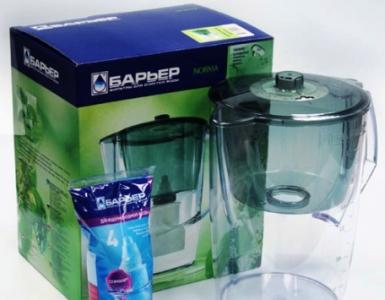Terminal block for wires of different cross-section. Wago terminal blocks for connecting wires
Those who are self-repairing home electrical wiring, constantly have to deal with such a concept as connecting wires. There are a lot of ways for this, from the ancient grandfather's method of twisting to modern terminal blocks. Regardless of what you are doing right now - the overhaul of the household electrical network or the connection of a new element (switch, luminaire or socket), the connection must always be reliable. This directly affects the safety of your home. Let's talk about what is still stronger and more profitable - use clamps for wires or twist them and solder them?
Does not go out of fashion twist
The modern market in such variety represents terminals for connection electrical wires, that, it would seem, it is high time to forget about twists. But for electricians this method persistently continues to be popular, despite the fact that the factory connectors provide safety and reliability. In addition, the terminals are much more convenient to use and look aesthetically pleasing than twisted wires rewound with electrical tape.
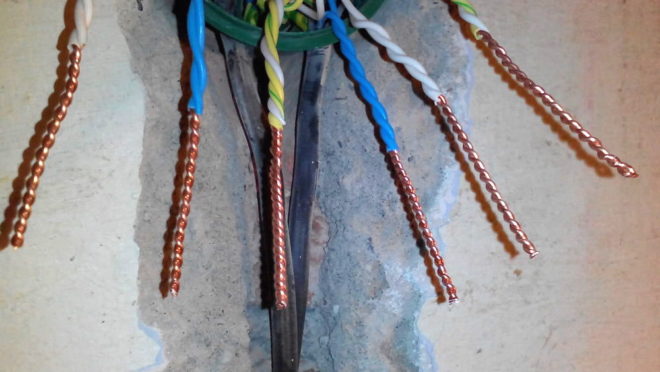
There is a twist yet another very serious flaw. If we consider this method objectively, it does not fit into one concept: a detachable connection or an unbroken connection. Logically, it is clear that the split ends can be severed repeatedly. But twisting can not be called a full-fledged connector, because each time after unwinding and re-twisting, the ends of the wires will deteriorate. Under the concept of a permanent connection twist also does not fit, because it does not have the necessary stability, strength and reliability.
How to make a good twist is told in this video:
But if you do not get used to twisting wires of wires, use at least instead of an insulating tape convenient and safe connecting caps.
Caps PPE
Caps are also called connecting insulating clamps (abbreviated PPE).
Structural design

Outside, the cap body is made of a plastic material. This material has a number of positive aspects:
- under the influence of open fire the combustion process does not support;
- it can withstand working voltage up to 600 V;
- has good insulating properties.
Plastic enclosure in addition to isolating the connection, it also protects it from mechanical damage.
Inside the cap is equipped with a crimp spring made of steel and having the shape of a cone. When the wire twist is inserted into the cap, the turns of this spring are further crimped.
When using caps, it is very important to properly separate the ends for twisting. The insulation layer must be cut so much that the bare metal is not outside the cap, and under the crimp spring it gets completely.
Preparing the wires for the caps
Now in the electrical world is already considered an error, to strip the wire or cable from the insulation layer with a knife. Professional electricians use special devices - removers of insulation.
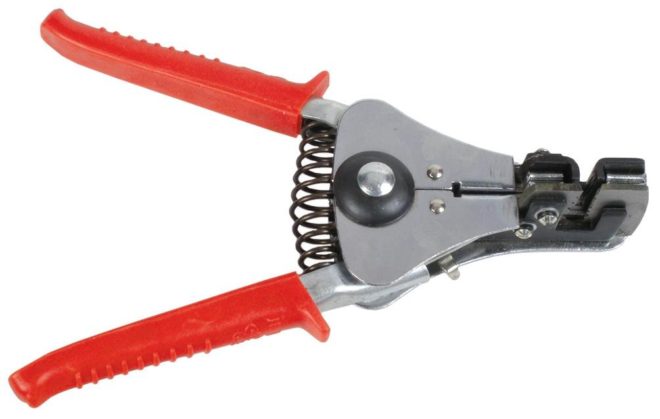
This device has calibrated holes for each standard diameter of the vein (at the cutting edge apertures). The insulation puller does not break the conductive surface layer, which keeps its strength.
The knife of a knife, too, is not canceled. The main thing is to position it when removing the insulation to the direction of the cut at an angle so as not to tangle the metal core. The location of the knife during the removal of the insulation layer at a right angle is not allowed, since there is a high probability that you will make a circular incision, as a result of which the vein may later break.
When choosing PPE caps special attention it is necessary to give the sizes of crimp springs. The main contact is created in its smallest conical part. It is very important that it matches the wires being connected. If the veins are thin, the conical spring will not tighten, and thick twisted strands, on the contrary, do not enter the cap until the end.
Connection of cores
The connection of wires with the help of PPE caps is practiced in two ways:
- Without preliminary twisting. Two veins, the same diameter, with force must be inserted into the spring. Then intensely perform the rotation of the cap in the clockwise direction. Thus, the length of the bare metal wires is twisted.
- If it is necessary to connect three or four cores, they must first be twisted with pliers, bite off the twisted tip, and then put on the cap, with an effort to rotate it clockwise.
Remember! In order for the PPE cap to fit tightly around the surface of the twist, it needs to be rotated only clockwise, but not in the opposite direction.
The cap should be worn with effort, so that the coils of the crimp spring are pulled apart and the connecting wires are firmly squeezed.
Never use PPE caps to connect the conductors from the different material. This applies to a greater degree to copper and aluminum, between which the passage electric current causes a galvanic process.
How to make a connection with caps is shown in this video:
Types of caps
Many electricians negatively refer to PPE caps. But this attitude can be caused by two reasons. Either the caps were incorrectly selected, or they were ineptly installed on the connecting wires.
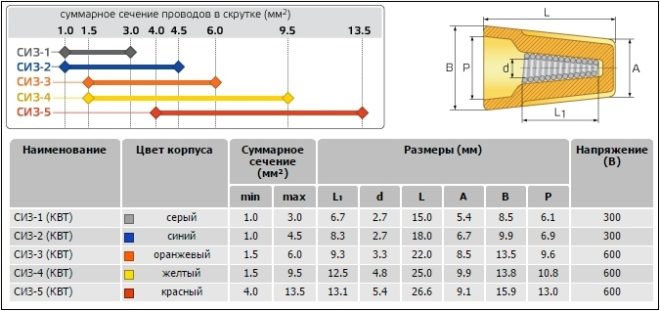
To properly select the caps to the dimensions of the wire, the manufacturers introduced a special color marking:
- SIZ-1 - connects two cores with a section of 1.5 mm 2 (gray);
- PPE-2 - connects three cores with a cross section of 1.5 mm 2 (blue);
- PPE-3 - connects two cores with a cross section of 2.5 mm 2 (orange);
- SIZ-4 - connects four cores with a cross section of 2.5 mm 2 (yellow);
- PPE-5 - connects eight wires with a cross section of 2.5 mm 2 (red).
True, there are no uniform international standards for such color marking. Therefore, it may differ from manufacturers from different countries. Be careful when buying, specify from the seller-consultant the required dimensions.
Terminal clamps
Terminal blocks for connecting wires give one indisputable advantage, they can connect wires from different metals. And here, and in other articles, we have repeatedly reminded that it is forbidden to twist wires made of aluminum and copper. The resulting galvanic vapor will result in the formation of corrosive processes and the destruction of the compound. And it does not matter how much current flows at the junction. Late or early, the twist will still begin to heat up. The way out of this situation is just the terminals.
Terminal block
The simplest and cheapest solution is polyethylene terminal blocks. They do not have a high price and are sold at every electrical store.

The polyethylene frame is designed for several cells, inside each there is a brass tube (sleeve). The ends of the connecting wires must be inserted into this sleeve and clamped with two screws. It is very convenient that so many cells are cut off from the pad, as it is necessary to connect pairs of wires, for example, in one junction box.
But not everything is so smooth, there are drawbacks. In room conditions, aluminum under the screw pressure begins to flow. It is necessary to perform periodic revision of the terminal blocks and tighten the contacts where the aluminum wires are fixed. If you do not do this in a timely manner, the aluminum core in the terminal block will loosen, lose reliable contact, as a result, spark, heat, which can result in a fire. With copper conductors, such problems do not arise, but it will not be superfluous to perform a periodic audit of their contacts.
Terminal blocks for connecting stranded wires are not intended. If the multi-stranded wires are clamped in such connecting terminals, during the screwing under the pressure of the screw, the thin veins can partially break, which will lead to overheating.

In the case where it becomes necessary to clamp the stranded wires into the terminal block, it is absolutely necessary to use auxiliary pin tips. It is very important to choose the correct diameter so that the wire does not jumped out. Stranded wire must be inserted into the tip, press with pliers and secure in the terminal block.
As a result of all of the above, the terminal block is ideal for single-core copper wires. With aluminum and stranded, you will have to observe a number of additional measures and requirements.
How to use the terminal blocks shown in this video:
Terminals on plastic pads
Another very convenient wire connector is the terminal on the plastic pads. From the terminal blocks this variant is distinguished by an even metal clamp. In the clamping surface, there is a recess for the wire, so there is no pressure on the core from the twisting screw. Therefore, these terminals are suitable to connect any wires in them.
In these clamps everything is extremely simple. The ends of the wires are cleaned and placed between the plates - contact and clamping.
These terminals are additionally equipped with a transparent plastic cover, if necessary, it can be removed.
Self-clamping terminals
The installation of wiring using these terminals is simple and quick.

Leave the wire in the hole to the very end. There it is automatically fixed by means of a clamping plate, which presses the wire to the tin-plated tin. Thanks to the material from which the clamping plate is made, the clamping force does not weaken and is maintained all the time.
The internal tinned tin is made in the form of a copper plate. Fixing in self-clamping terminals can be copper, and aluminum wires. Such terminals are disposable.
And if you want clamps for connecting reusable wires, then use terminal blocks with levers. They picked up the lever and put the wire in the hole, then fixed it there by pressing it back. If necessary, the lever again rises and the wire protrudes.
Try to choose clamps from the manufacturer, which has proven itself well. Especially positive characteristics and reviews have clamps of the company «WAGO ».
The advantages and disadvantages are described in this video:
Scotch Lok
Couplings of this type - single use. They are used for wires with small working currents (telephone lines or wires for low-power LED lamps).
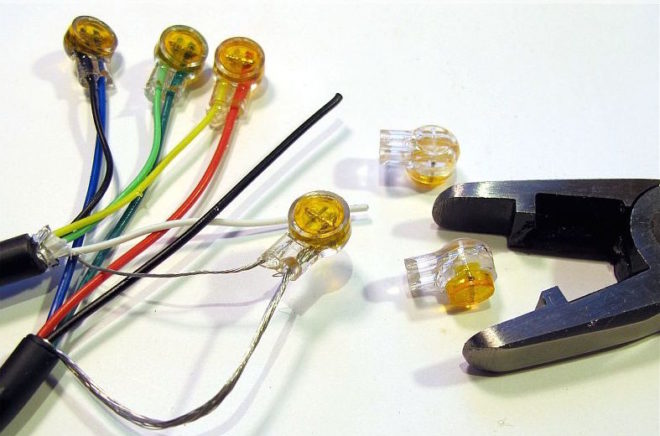
Such clamping sleeves are connected by means of a shearing contact. Wires do not even need to be cleaned before joining. Directly in the insulating layer they are inserted into the Scotch-Lokas and crimped with pliers. The plate, which has cutting contacts, cuts into the insulation layer, due to which there is a contact between the veins.
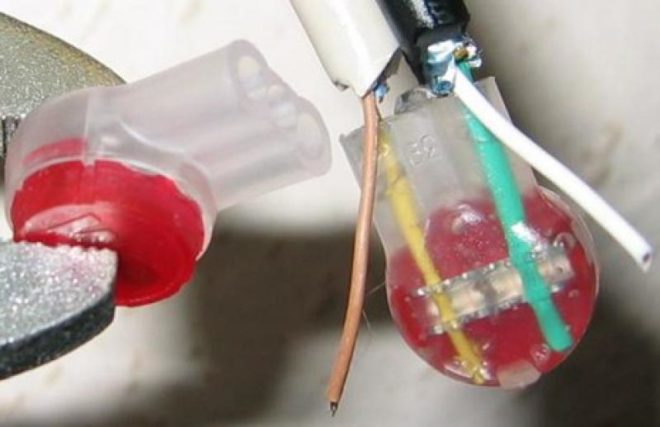
In addition to the fact that no stripping of the veins is required, Scotch-Loks have a number of other advantages:
- low cost;
- universality;
- do not need special devices, crimping is done by ordinary pliers;
- waterproof (inside the coupling there is a hydrophobic gel, which protects the contact from moisture and corrosion).
- If the clutch tape needs to be replaced, it is simply cut out, and a new one is installed in its place.
Cases
When powerful clamps for several wires are needed, they use sleeves. They are a tin tube of copper, or a flat tip with a hole for fixing.

In the sleeve, it is necessary to insert all the connecting wires and crimp it with a special crimper attachment (crimping pliers). Such a clamp for wires has a number of positive sides:
- It is very convenient to use handpieces with holes when it is necessary to fasten the knots of the wires to the housings with the help of screws.
- Crimping at the junction does not contribute to increased resistance.
As you can see, there are a lot of wires for wires, each with its own merits and demerits. Choose, based on what wires you need to connect, where the location of the connection will be located. But do not forget that the most important thing in electricity is reliability and safety.

Connection of conductors by means of disposable terminal blocks is carried out in the following way: stripped (approximately 1 cm) wires are inserted into the terminals until they stop. Inside the terminal block is a clamp, which securely fixes the wire.
The wire can only be pulled out of the terminal block by applying considerable force, but in this case the locking clip is deformed and the terminal strip can not be reused. If necessary, you can read about.
Reusable Wago terminal blocks
Reusable Wago terminal blocks are very popular. The best model is a series 222 connector with an orange lever, designed to fix the wire. These terminals come with jacks for 2, 3 and 5 wires. With their help, it is possible to connect both solid and stranded wires.

To do this, raise the locking lever in the terminal block, thus opening the terminal. You need to insert the pre-stripped wire (approximately 1 cm) to the stop; lower the locking lever, clamping the wire. Thanks to these terminals you can easily.
Advantages of Wago terminal blocks
Using Wago terminals has several advantages:
- easy to use: cleaned - pasted - fixed, which greatly reduces the time of installation;
- does not require additional isolation;
- reliable fixation of the conductor without damaging it;
- a strong connection of solid stranded wires with stranded wires, since a separate socket is provided for each wire in the terminal block;
- safe and long-term connection of copper and aluminum wires;
- ensuring a reliable electrical contact, eliminating heat and short circuit;
- possibility of reconnection - if you need to change the circuit, connect a new device, etc. - with terminal blocks Wago Wire can quickly be disconnected and reconnected;
- possibility of measuring parameters electrical circuit, without breaking the connection.
As you can see, you can use terminal blocks to connect wires. We hope, thanks to the article, you learned how to connect the wires to the terminal blocks.
Service electrical networks inevitably accompanied by work with the electricians for the terminals. This is a kind of small mounting hardware, without the use of which it is difficult to manage, making connections of wires between each other or with electrical equipment. Time excluded from practice obsolete terminals for connecting wires, but stably complements the base of electrical engineering with new developments - more sophisticated ones.
Considering all terminals produced by the industry for the connection of wires, we should immediately make a reservation and divide the products into two types: electrical and electrotechnical.
In fact, the difference (in current load) between species is often small, but still it is available. This point should be borne in mind when selecting electrical terminals for installation, repair or other activities.
Terminal connections are used in electrical throughout. This is one of those electrical components, without which it is inconceivable that any plan
Faced with the need to select electrical terminals for wires, start better with the simplest designs of domestic production - reliable, durable, proven in the business more than once:
- knife blades;
- ring;
- pin;
- muff.
Connections at the device of electric schemes can be executed by a different technique and terminals are only one of variants. However, this option is seen as the simplest, most convenient and even economical in comparison, for example, with soldering, welding, including cold welding.
Option # 1: "scabbard"
This, perhaps, is the most common design options for products. They can often be found in the electrical circuits of many household appliances: irons, refrigerators, heating devices, etc. But for connections of conductors of power electrical wiring, for example, in electrical housing shields, they are not intended.
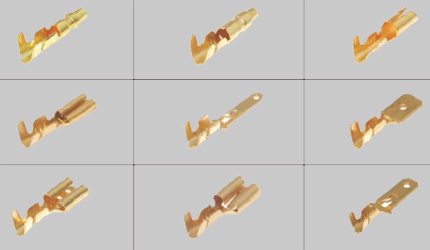
It is familiar to many electricians and a widespread type of terminal blocks, the connection of which is carried out according to the principle of knife contact. To organize the connection it is enough to insert one part (dad) into the other (mum)
To establish this type of electrical products is acceptable for conductors (stranded) with a cross section of 0.26 - 6.0 mm by the method of force crimping the shank. There are two types of such products: isolated and non-insulated. The insulation is usually painted in different colors (red, blue, yellow), depending on the calculated power of the terminal board. The products are applied in pairs in the bundle "Papa-Mama".
Option # 2: round
Ring products are configured for screw fastening and are represented by two groups. Both groups are classified as non-isolated terminals. The first group includes constructions of a closed ring with a shank. The second group consists of fork-type constructions with rupture of the ring contour, also with a shank. Both are widely used in electronic circuits.

Another "ancient" kind of elements, with the help of which an electrical connection of the conductor with any modular element of the circuit is created. These terminals can be used to contact two wires, but in practice such a rarity
Ring type terminal blocks of the first type are available in an assortment wider than the second type. And the possibilities for their application are more extensive, considering specifications. This type of electrical products may be installed on electrical conductors of 0.25 - 16.8 mm. And the fork configuration of the connection terminals for the wires is only for the cross section of the wire 0.25 - 4.6 mm.
Option # 3: pin
This group of connecting terminals for electrical wires is made on the principle of a detachable part consisting of two separate elements - plugs and sockets. The plug is marked with the symbol "A", for example, F2A. The socket is marked with the symbol "B", for example, F2B. Supports mounting to conductors of 1.25 - 6.64 mm. The main purpose of the whip terminals is to ensure the connection of electrical conductors.
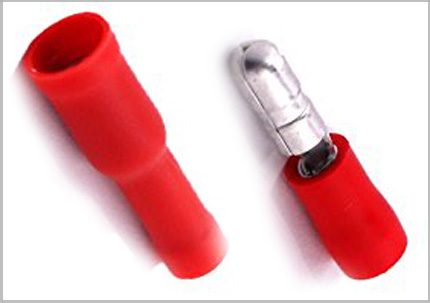
One of the variants of the pin design of the terminal blocks, used, as a rule, in low-current circuits. Structurally provide convenient operation for installation / dismantling
This group of mounting hardware refers to insulated products. The tail part of the terminals is closed with insulating material. Depending on the design capacity of the terminal block for connecting the wires, the insulator has an appropriate color. Insulators of electrical terminals for conductors of cross section up to 2 mm are painted blue, the others (from 2 to 6.64 mm) - in yellow.
Option # 4: coupling retainers
Another type of connecting armature is a coupling collar made in the form of a metal tube.
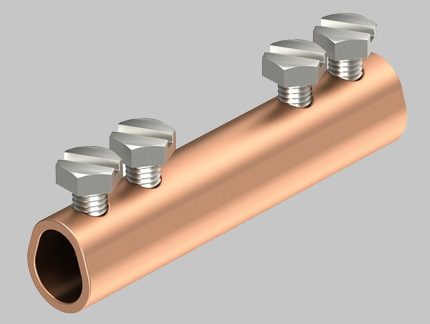
The so-called coupling clamp. Available in different configurations, including under power crimping. In the figure, the terminal block design capable of withstanding high currents
The couplings are designed for installation on electrical conductors of 0.25 - 16.78 mm. Fixation is carried out by the method of force crimping of a part of the tube or by means of bolts screwed into the threaded holes on the coupling body. As a rule, the crimp couplings are not used for connection of single-core wires.
Foreign products
In recent years, the market has filled with terminal blocks of foreign production. It is necessary to give due: technologically foreign designs look more perfect in comparison with domestic products. With them it is more convenient to work - faster and easier to make connections.
But from the point of view of the reliability of the connections made by a foreign product, not everything is so unambiguous. In this regard, the domestic product often looks preferable. However, consider some examples.
Noteworthy are the electrical terminals manufactured by WAGO. The engineers of the company invented several attractive designs, where a conventional terminal turns into a convenient interface for connecting: Push wire, Power cage clamp, Cage clamp.
Push Wire connectors for wires
The technology of Push Wire is based on the use of the properties of the rigidity of the electrical conductor, due to which they get completely reliable contact. This type of terminal block is most suitable for working with solid wire. Indeed, the quick way to connect Push Wire provides unconditionally.

The product of a well-known German company is a modification called Push wire. Easy-to-use variation of single and group terminal block
It is enough only to strip the end part of the wire (by 10-15 mm) and push the peeled end inside the terminal with a slight effort. And in order to quickly extract the conductor, it needs to be pulled with simultaneous scrolling around its axis.
Two types of Push-Wire connectors have been developed:
- Under a single conductor.
- Under the group of conductors.
The configuration of the group connection is designed to work with wires of less stiffness than in the case of a single option. A somewhat different mechanical clamping design is used here. To open access to the conductor entry holes, it is necessary to apply some effort to the push button. Also there are models Push wire without a button - under pressure by screwdriver.
Universal Power cage clamp
This terminal block belongs to the category of universal developments. It is made for any type electric wire section 6 - 95 mm. Structurally Power cage clamp is a so-called double cell where there is a spring press and a current-carrying bus.
![]()
Universal terminal for connection of conductors of different cross-section. An engineering solution that provides reliable tight contact. This type of connection accessory can be used to install lines of different power
The electrical conductors are connected to these terminals using a hex wrench. Rotating the key, the spring is compressed, the end of the wire is inserted under the press, then the key is turned counter-clockwise. As a result, the press is lowered and reliably presses the inserted end of the wire.
Set of Cage clamp
This is a unique (patented WAGO) product, which received the characteristic of a terminal block for wires. The WAGO terminal blocks are designed for installation on 0.5 to 35 mm wires. They are well suited not only for working with single-core wire, but also with multi-core wires, regardless of the degree of fineness of individual wires.
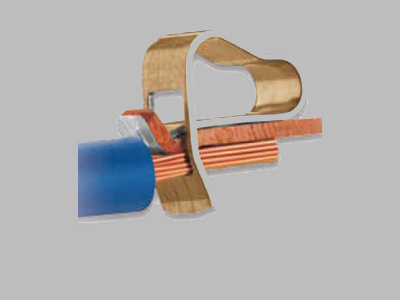
The simplest, but effective design of the terminal block from WAGO. The figure shows the performance of an open type, but in practice it is usually necessary to deal with type-locked terminal blocks of the buried type
The Cage clamp works simply: using a screwdriver (or special lever in other modifications), the spring clip is lifted, the wire is inserted under the current-carrying bus, and then the clamp is lowered into place. Despite the simplicity of the design, the manufacturer claims: the clamping force on the contact is automatically adjusted and depends directly on the wire cross-section.
Set of Cage clamp S
The variant of a wire connector, almost similar to the above described product. But the design of the Cage clamp S is still somewhat different. The peculiarity of the "S" modification is the ability to work with this type of terminal without using any tools of the electrician.
Plus, the terminal block of the modification "S" is designed for conductors of high enough rigidity - multi-core and single-core. It is also permissible to connect wires with metal tips to the terminal. Working with Cage clamp S is very simple: the end (cleaned) part of the conductor is inserted with some force until it stops, after which the connection is established.

Modified version of the composite wire connector. It is more convenient for operation. It makes it possible to create a connection of wires without too much effort and just as easy to dismantle
The connection terminals for the wires from the Gage clamp S series found a place in almost all modifications of the group multi-row terminal blocks. They are convenient to use for the installation of numerous low-current electric lines. However, the successfully closed design of the Cage clamp S is also used in high current circuits.
There are two modifications completely closed in the insulation structure "S". One involves fastening the wire while pressing the plate in the front direction. The other is designed for lateral pressing by a screwdriver on a spring plate.
Screw wire connectors
Screw connectors are widely used in the electric power industry, in fact, they are a variation of a tubular (boxed) product. They are made in the form of a tube of rectangular shape, but having a rounded (oval) bottom.
On the upper plateau of such a tube there are holes with thread, where the locking screws are screwed. The whole construction is enclosed in capron insulation. Passage channels are made to access the screws in the insulation body. There are two types of these terminals for connecting wires - single and group.

The design (one of the many) screw terminals for connecting four electrical wires. Coupling version closed type with the possibility of mounting on a DIN rail
Screw terminals for connecting wires are inherent:
- pronounced mechanical strength;
- possibility of working with cables up to 25 mm;
- use in circuits of weak currents and power.
It is not difficult to work with this kind of connectors.
The end parts of the wires are inserted inside the brass tube and the screwdriver is tightened with stop screws (usually two screws). In turn, the screws press the conductor to the bottom of the metal tube.
Video review of electrical terminal blocks for wires
The presented video material will expand your knowledge of the types of terminals and methods of their installation.
Electric installation works rarely do without the use of the described accessories. It would seem that these are small parts, which can easily be discarded by replacing the technological connection with the usual twisting of wires. Only now the practice of electrical engineering is marked by a mass of cases when it is the banal twisting of conductors that instead of a reliable terminal connection that leads to tragic consequences.


